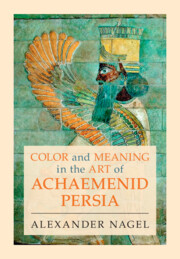Book contents
- Color and Meaning in the Art of Achaemenid Persia
- Color and Meaning in the Art of Achaemenid Persia
- Copyright page
- Contents
- Figures
- Acknowledgments
- Introduction: The Most Beautiful Blues
- Chapter One Defining Polychromies
- Chapter Two Historiographical Overview, Part I: Approaching Achaemenid Persian Polychromies in the Nineteenth Century – Ancient Literary Testimony and Modern Discourses
- Chapter Three Historiographical Overview, Part II: Approaching Achaemenid Persian Polychromies in the Twentieth Century
- Chapter Four Uncomfortable Truths: Challenges of Documenting and Preserving Achaemenid Persian Polychromies
- Chapter Five A Discussion: Aspects of Nonverbal Communication in the Achaemenid Persian Empire
- Chapter Six Concluding Contemplations
- Bibliography
- Index
Introduction: The Most Beautiful Blues
Published online by Cambridge University Press: 24 August 2023
- Color and Meaning in the Art of Achaemenid Persia
- Color and Meaning in the Art of Achaemenid Persia
- Copyright page
- Contents
- Figures
- Acknowledgments
- Introduction: The Most Beautiful Blues
- Chapter One Defining Polychromies
- Chapter Two Historiographical Overview, Part I: Approaching Achaemenid Persian Polychromies in the Nineteenth Century – Ancient Literary Testimony and Modern Discourses
- Chapter Three Historiographical Overview, Part II: Approaching Achaemenid Persian Polychromies in the Twentieth Century
- Chapter Four Uncomfortable Truths: Challenges of Documenting and Preserving Achaemenid Persian Polychromies
- Chapter Five A Discussion: Aspects of Nonverbal Communication in the Achaemenid Persian Empire
- Chapter Six Concluding Contemplations
- Bibliography
- Index
Summary
Behind glass doors in a repository in the basement of the National Museum of Asian Art at the Smithsonian Institution in Washington, DC, remain a modest number of beautiful pigments from almost 2,500-year-old stone façades on the sites of Persepolis, Naqsh-e Rustam, and Pasargadae in Iran (Figures I.1–I.3). Away from the ruins of the monuments standing calm and in gentle dignity in Fars in southern Iran, these tiny pigments, stuck on paper squeezes made on the sites only two generations ago provide an amazing opportunity to approach and better understand the aesthetics and sensual visual culture of the great palaces and environs of Achaemenid Persia. Even more, the residues are a window into the world of the craftsmen and people who built Persepolis and other sites. They are part of the great narrative connecting painters, people, places, and traditions across cultures and times, connecting the largest world empire between the late sixth and mid fourth centuries bce and beyond with today. They are at the heart of this book.
- Type
- Chapter
- Information
- Color and Meaning in the Art of Achaemenid Persia , pp. 1 - 19Publisher: Cambridge University PressPrint publication year: 2023

